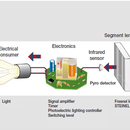Introduction: LI-Fi V/s WiFi
In this article, we shall understand the basic differences between LIFI and WIFI technologies.
Thomas Edison could have hardly imagined that his invention- LIGHT BULBS, one day, might be used not only to illuminate homes but also to transmit data that would enable people to download information from satellites in space to small hand-held devices. But with Li-Fi, this seems to be true.Li-Fi stands for Light Fidelity.
Step 1: Description
LI-FI is a new technology which claims to be 100 times faster than the current WI-FI technology. LI-FI uses which was first invented by Harold Haas of the University of Edinburgh in 2011, uses visible light communication (VLC) to send data at extremely high speeds. Essentially, this works like an incredibly fast signal lamp, flashing on and off in order to relay messages in binary code (1s and 0s).
In previous lab-based experiments, the technology was able to transmit up to 224 gigabits per second. To put this in perspective, Wi-Fi is capable of reaching speeds of around 600 megabits per second.
The technology has now been deployed in real-life situations for the first time, thanks to the work of Estonian start-up Velmenni, which has begun trialing Li-Fi in offices and other industrial settings in Tallinn. In these environments, they were able to achieve connection speeds of around one gigabit per second The picture depicts how LI-FI is going to be a part of our future.
Step 2: Comparision Between Lifi Vs Wifi
- Full form
- Light Fidelity
Wireless Fidelity
- Operation
- Li-Fi transmits data using light with the help of LED bulbs.
- Wi-Fi transmits data using radio waves with the help of Wi-Fi router.
Interference
- Li-fi do not have any interference issues similar to radio frequency waves.
Wi-fi will have interference issues from nearby access points(routers)
Technology
- Li-fi is Present IrDA compliant devices
WLAN 802.11a/b/g/n/ac/ad standard compliant devices
Applications
- Li-fi is used in airlines, undersea explorations, operation theaters in the hospitals, office and home premises for data transfer and internet browsing
Used for internet browsing with the help of WI-FI kiosks or WI-FI hotspots
Merits(advantages)
- In Li-fi interference is less, can pass through salty sea water, works in more dense region
In Wi-fi interference is more, cannot pass through sea water, works in lesser dense region
Privacy
- In Li-Fi, light is blocked by the walls and hence will provide more secure data transfer
In Wi-Fi, RF signal cannot be blocked by the walls and hence need to employ techniques to achieve secure data transfer.
Data transfer speed
- Li-fi: About 1 Gbps
- Wi-fi: WLAN-11n offers 150Mbps, About 1-2 Gbps can be achieved using WiGig/Giga-IR
Frequency of operation
- Li-fi: 10 thousand times frequency spectrum of the radio
- Wi-fi: 2.4GHz, 4.9GHz and 5GHz
Data density
- Li-fi: Works in high dense environment
- Wi-fi: Works in less dense environment due to interference related issues
Coverage distance
- Li-fi: About 10 meters
- Wi-fi: About 32 meters (WLAN 802.11b/11g), vary based on transmit power and antenna type
System components
- Lamp driver, LED bulb (lamp) and photo detector will make up complete Li-Fi system.
- Wi-fi requires routers to be installed, subscriber devices(laptops,PDAs,desktops) are referred as stations













